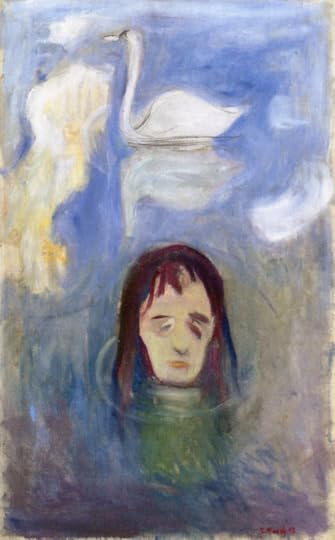Deep in My Heart, I do Believe
Merril D. Smith
Never again, we say,
never again,
never again.
But they scream—again—
time-space ripples
in a Munch vision
again and again
books banned
and women dying
…
You may find the rest of the poem here.
“Deep in My Heart, I do Believe” tackles important themes of violence, oppression, and the quest for justice. It begins with the repeated phrase “never again,” which captures a strong sense of urgency and frustration about the cycles of history that keep repeating. This repetition implies a shared promise to avoid past mistakes, yet the poem quickly shifts to reveal that these promises are often broken, showing the harsh reality of ongoing suffering. This creates a stark contrast between hope and despair. The poem also connects deeply to Edvard Munch’s painting “Vision,” using imagery that reflects chaos and emotional turmoil, mirroring the anxiety found in both the artwork and the violence described in the poem.
Structured in free verse, the poem employs varied line lengths and repetition to create a rhythmic flow. This format reflects the chaotic nature of its themes, allowing readers to feel the weight of each line. The repetition drives home the message that despite our promises, history continues to repeat itself, whether through banned books, the suffering of women, or violence against marginalized communities.
Imagery such as “time-space ripples” evokes a sense of turmoil and emotional intensity, suggesting a world stuck in cycles of trauma. The line “they scream—again” illustrates the frustration surrounding these ongoing injustices. Moments of darkness, like “bodies bombed, gassed, beaten,” are juxtaposed with calls for hope, such as the “call for bread and roses.” This contrast emphasizes the need to strive for joy and justice, even when faced with overwhelming odds. The imagery also aligns with Munch’s style, where emotions twist reality, capturing the profound impact of violence on individuals and society.
The narrative shifts from the harsh realities of violence to a call for hope and resilience. The line “I can’t breathe” conveys a feeling of suffocation from repeated traumas. Yet, it transitions to a collective response, with the speaker vowing to “hold your ghost-breaths” in their hearts. This commitment honors those lost while continuing the fight for a better future.
As this piece moves forward, it becomes a rallying cry for action, suggesting that rising against oppression is part of the human spirit. The call for “bread and roses” symbolizes the fight for basic needs and happiness, showing that pursuing joy is as vital as survival. The closing lines, with the declaration “we rise,” encapsulate determination and strength, reminding us that even amid cycles of violence, there is a spirit of resilience and a desire for change, rooted in community and solidarity.
The poet reminds us of the ongoing struggle against injustice and the importance of remembering and being resilient. It captures the frustration of seeing history repeat itself while still offering hope. By intertwining Munch’s emotional weight with current issues of violence and oppression, the poem reinforces the power of community and the need for a hopeful future.
Edvard Munch – Vision (1892)

This image can be found here.
Edvard Munch

Edvard Munch (1863-1944) was a Norwegian painter and printmaker, best known for his emotionally charged works that explore themes of love, anxiety, and existential despair. Born in Loten, Norway, Munch faced personal tragedy early in life, losing his mother to tuberculosis when he was just five. These experiences of loss and illness would deeply influence his art.
Munch’s artistic style is often associated with Symbolism and Expressionism. He employed vivid colors and dramatic compositions to evoke intense emotional responses. His most famous work, “The Scream,” captures a profound sense of existential dread, embodying the anxieties of the modern age. The painting’s swirling colors and distorted forms are hallmarks of Munch’s approach, which sought to convey psychological states rather than mere visual reality.
Influenced by a range of artistic movements and figures, Munch drew inspiration from Impressionism, Post-Impressionism, and the Symbolist movement. His encounters with artists like Vincent van Gogh and Henri Toulouse-Lautrec enriched his understanding of color and form. Additionally, Munch’s own experiences with mental health, including bouts of depression, informed his exploration of human emotion.
Throughout his career, Munch created a vast body of work, including paintings, prints, and drawings, focusing on themes of love, anxiety, and mortality. His innovative use of color and form paved the way for later developments in modern art, particularly in Expressionism.
Munch’s legacy endures, as his works continue to resonate with audiences worldwide. He is regarded as a pioneer of modern art, influencing countless artists and movements in the 20th century and beyond. His exploration of psychological themes and the human condition remains relevant, securing his place as one of the most significant figures in art history.
You may learn more here.



